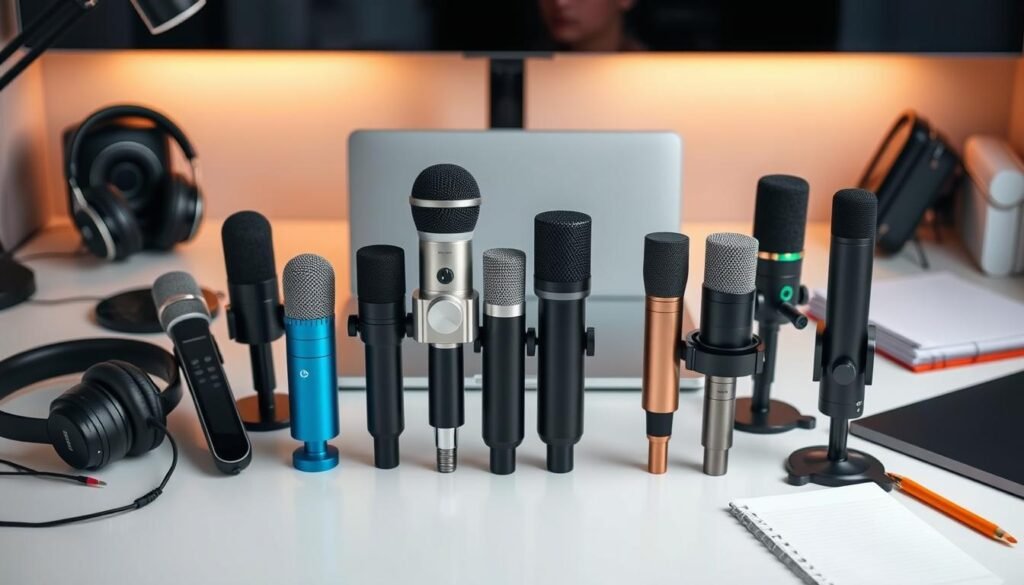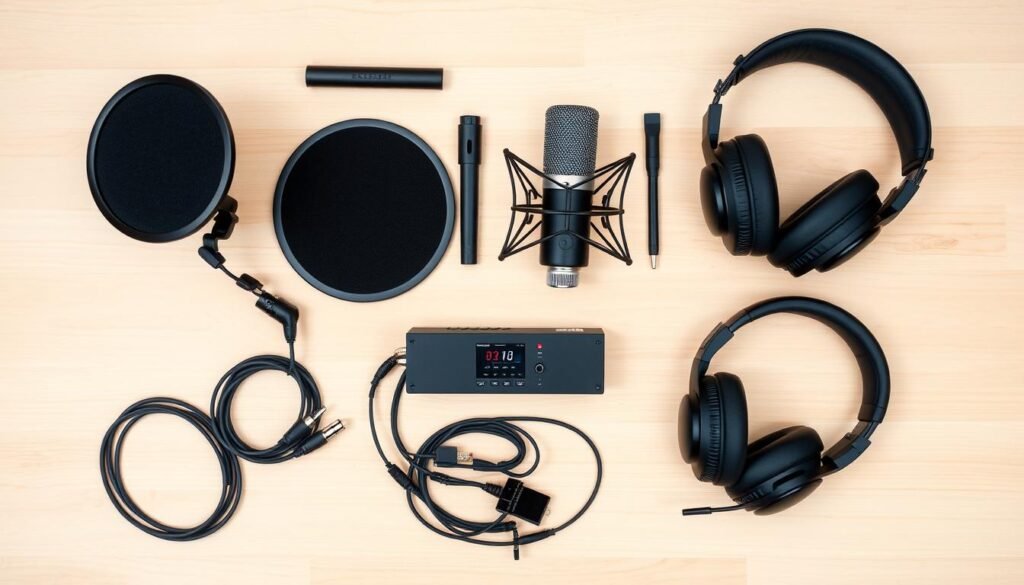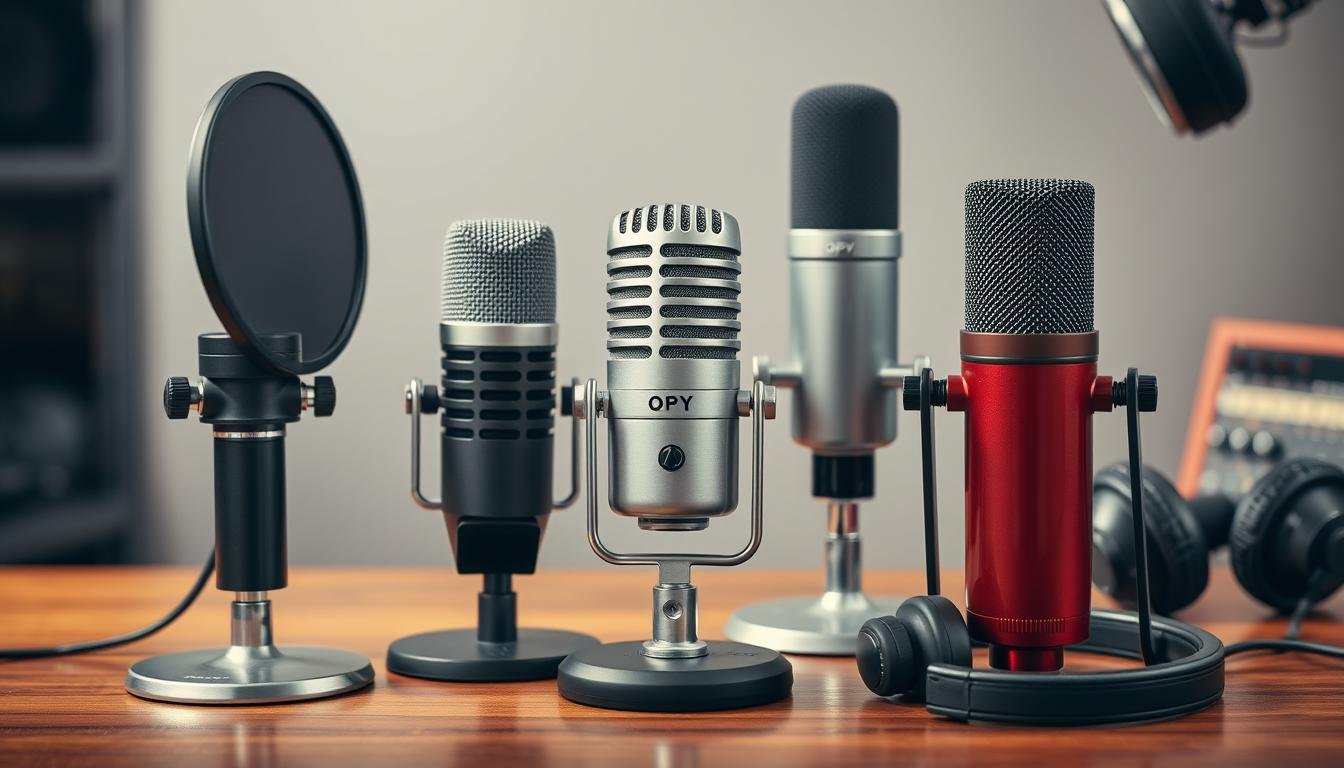“The podcast is the new fireside chat.” – Gary Vaynerchuk
In the world of podcasting, your voice is your most powerful tool. The right microphone can make or break your show’s audio quality. As we dive into 2024, the quest for the best microphones for podcasting continues. This guide will help you navigate the sea of podcast mics and audio equipment for podcasters, ensuring your voice reaches listeners with crystal clarity.
From USB plug-and-play options to professional-grade XLR setups, we’ll explore the top picks that cater to both budding podcasters and seasoned pros. Our goal? To help you find the perfect microphone that fits your needs, budget, and recording style.
Key Takeaways
- Quality microphones are crucial for professional-sounding podcasts
- USB mics offer simplicity for beginners, while XLR options provide versatility for pros
- Popular brands like Shure, Rode, and Audio-Technica offer reliable podcast mics
- Consider factors such as sound quality, connectivity, and budget when choosing a mic
- Proper mic setup and room acoustics play a vital role in audio quality
Importance of Selecting the Right Microphone for Podcasting
Choosing the perfect microphone is crucial for podcast success. Top-rated podcast microphones can make or break your show’s sound quality. Let’s explore key factors to consider when selecting voice recording gear for your podcast setup.
Sound Quality vs. Price
Balancing sound quality with budget is essential. While high-end microphones offer superior audio, many affordable options provide excellent results for beginners. Consider your podcast goals and invest in the best microphone you can afford.
Connectivity Options
Microphones come with various connectivity options. USB mics are plug-and-play, ideal for solo podcasters. XLR microphones require additional equipment but offer professional-grade sound. Your choice depends on your technical expertise and recording setup.
Type of Microphone
Dynamic and condenser microphones are popular for podcasting. Dynamic mics excel in noisy environments, while condensers capture subtle voice nuances. Your recording space and voice characteristics influence the best choice for your podcast.
“The right microphone can elevate your podcast from amateur to professional-sounding in an instant.”
Understanding these factors helps you select the perfect voice recording gear for your needs. Remember, the best microphone is one that fits your budget, setup, and podcasting style.
| Microphone Type | Best For | Price Range | Connectivity |
|---|---|---|---|
| Dynamic | Noisy environments | $50 – $400 | XLR, USB |
| Condenser | Quiet studios | $100 – $1000 | XLR, USB |
| USB | Beginners | $50 – $200 | USB |
| XLR | Professionals | $100 – $1000+ | XLR |
Key Features to Consider in Podcasting Microphones
When selecting audio equipment for podcasters, understanding key microphone features is crucial. These features impact sound quality, recording environment compatibility, and longevity of your gear.
Frequency Response
Frequency response determines how a microphone captures different sound frequencies. For podcast mics, a flat response in the vocal range (around 80 Hz to 8 kHz) is ideal. This ensures clear, natural voice reproduction without artificial boosts or cuts.
Directionality
Directionality, or polar pattern, refers to how sensitive a microphone is to sounds from different directions. Cardioid patterns are popular for podcasting as they focus on sound from the front while rejecting background noise. This pattern helps maintain vocal clarity in less-than-perfect recording spaces.
Durability
Podcast mics should withstand regular use and potential travel. Look for robust build quality, especially if you plan to record on location. Metal construction often indicates better durability than plastic. Some microphones come with protective cases, adding an extra layer of security for your investment.
“A great microphone is the foundation of clear, professional-sounding podcasts. Choose wisely, and your listeners will thank you.”
By considering these features, you’ll be better equipped to choose the right podcast mics for your specific needs. Remember, the best microphone is one that fits your budget, recording environment, and podcasting style.
Top Dynamic Microphones for Podcasting
Dynamic microphones for podcasts are a popular choice among podcasters. They excel in capturing clear vocals and rejecting background noise. Let’s explore some top-rated podcast microphones that stand out in 2024.
Shure SM7B
The Shure SM7B is a legendary dynamic microphone. It offers studio-quality sound and excellent noise rejection. This mic shines in both amateur and professional setups. Its smooth, warm tone makes voices sound rich and broadcast-ready.
Audio-Technica ATR2100x
The Audio-Technica ATR2100x is a versatile and budget-friendly option. It features both USB and XLR outputs, making it ideal for beginners and pros alike. This mic delivers clear audio and minimizes room noise effectively.
Rode PodMic
Rode designed the PodMic specifically for podcasting. It boasts an internal pop filter and sturdy build quality. The PodMic produces warm, detailed vocals and handles plosives well. Its compact size is perfect for home studios or on-the-go recording.
| Microphone | Connectivity | Frequency Response | Price Range |
|---|---|---|---|
| Shure SM7B | XLR | 50 Hz – 20 kHz | $399 – $499 |
| Audio-Technica ATR2100x | USB/XLR | 50 Hz – 15 kHz | $99 – $129 |
| Rode PodMic | XLR | 20 Hz – 20 kHz | $99 – $129 |
These dynamic microphones offer excellent options for podcasters at various skill levels and budgets. Consider your specific needs and recording environment when choosing the best microphone for your podcast setup.
Best Condenser Microphones for Podcasting
Condenser microphones for podcasts offer exceptional audio quality and sensitivity, making them a top choice for voice recording gear. These microphones capture crisp, detailed sound, perfect for creating professional-grade podcasts. Let’s explore two popular options that stand out in the world of podcasting.
Blue Yeti
The Blue Yeti is a versatile USB condenser microphone that’s become a favorite among podcasters. It offers four polar patterns, allowing users to customize their recording setup. The Yeti’s plug-and-play design makes it easy for beginners to start recording high-quality audio right away.
Rode NT1-A
The Rode NT1-A is a professional-grade XLR condenser microphone known for its warm, natural sound. It’s particularly well-suited for vocal recordings, making it an excellent choice for podcasters who prioritize audio quality. The NT1-A’s low self-noise ensures clean recordings, even in quieter environments.
| Feature | Blue Yeti | Rode NT1-A |
|---|---|---|
| Connection Type | USB | XLR |
| Polar Patterns | 4 (Cardioid, Bidirectional, Omnidirectional, Stereo) | 1 (Cardioid) |
| Frequency Response | 20Hz – 20kHz | 20Hz – 20kHz |
| Self-Noise | Not specified | 5dBA |
Both these condenser microphones for podcasts offer excellent sound quality and unique features. Your choice depends on your specific needs, budget, and existing voice recording gear setup.
USB vs. XLR Microphones: Which Is Better?
Choosing the right microphone for podcasting can be tricky. The debate between USB microphones for podcasting and XLR microphones for podcasts is ongoing. Let’s explore the benefits of each to help you make an informed decision.
Benefits of USB Microphones
USB microphones offer simplicity and convenience. They’re plug-and-play devices that connect directly to your computer. This makes them ideal for beginners or those with limited technical knowledge. USB microphones are cost-effective and don’t require additional equipment like audio interfaces.
- Easy setup and use
- Affordable option for beginners
- Portable for on-the-go recording
Advantages of XLR Microphones
XLR microphones are favored by professional podcasters. They offer superior sound quality and versatility. XLR microphones for podcasts connect to audio interfaces, allowing for more control over your sound. They’re also more durable and can be used with a variety of audio equipment.
- Professional-grade audio quality
- Greater control over sound
- Compatibility with various audio equipment
| Feature | USB Microphones | XLR Microphones |
|---|---|---|
| Ease of Use | High | Moderate |
| Sound Quality | Good | Excellent |
| Additional Equipment | Not Required | Audio Interface Needed |
| Price Range | $50 – $200 | $100 – $1000+ |
Your choice between USB and XLR microphones depends on your podcasting goals, budget, and technical skills. Both types can produce quality recordings, so consider your specific needs when making your decision.
Best USB Microphones for Beginners
Starting your podcasting journey? USB microphones for podcasting offer an ideal entry point. These devices combine ease of use with quality sound, making them perfect for newcomers. Let’s explore two standout options that balance features and affordability.
HyperX QuadCast
The HyperX QuadCast stands out as a feature-rich USB microphone for podcasting. Its vibrant red LED indicator clearly shows when you’re live, preventing awkward silent moments. The built-in pop filter ensures crisp audio quality, while the tap-to-mute sensor adds convenience to your recording sessions.

Samson Q2U
The Samson Q2U shines as one of the most versatile affordable podcast microphones. It offers both USB and XLR connections, allowing you to upgrade your setup without replacing your mic. Its dynamic capsule excels at rejecting room noise, making it ideal for less-than-perfect recording environments.
| Feature | HyperX QuadCast | Samson Q2U |
|---|---|---|
| Connection Type | USB | USB and XLR |
| Polar Pattern | Multiple (Stereo, Omnidirectional, Cardioid, Bidirectional) | Cardioid |
| Built-in Pop Filter | Yes | No |
| Mute Function | Tap-to-mute sensor | On/Off switch |
Both microphones offer excellent value, combining user-friendly features with impressive sound quality. Your choice depends on your specific needs and future upgrade plans. Remember, the best microphone is one that encourages you to keep recording and improving your podcast.
Best XLR Microphones for Professional Podcasters
For seasoned podcasters seeking top-notch audio quality, XLR microphones are the go-to choice. These professional-grade tools offer superior sound and versatility, making them ideal for high-end productions. Let’s explore two standout options in the world of top-rated podcast microphones.
Sennheiser e835
The Sennheiser e835 is a dynamic XLR microphone that shines in podcast recordings. Its clear sound reproduction and ability to handle high sound pressure levels make it a favorite among professionals. The e835 excels at rejecting off-axis sounds, ensuring your voice stays front and center.
Electro-Voice RE320
Another stellar choice for XLR microphones for podcasts is the Electro-Voice RE320. This versatile mic delivers broadcast-quality audio with its wide frequency response and variable-D technology. It’s particularly adept at capturing deep, rich tones, making it perfect for podcasters with lower voices.
| Feature | Sennheiser e835 | Electro-Voice RE320 |
|---|---|---|
| Type | Dynamic | Dynamic |
| Frequency Response | 40 Hz – 16 kHz | 30 Hz – 18 kHz |
| Polar Pattern | Cardioid | Cardioid |
| Best For | Vocal clarity | Rich, deep tones |
Both these XLR microphones for podcasts offer exceptional build quality and durability, ensuring they’ll withstand the rigors of regular use. When choosing between them, consider your voice type and the specific needs of your podcast to find the perfect match.
Essential Accessories for Podcasting Microphones
To elevate your podcast’s sound quality, investing in the right audio equipment for podcasters is crucial. Beyond the microphone itself, several accessories can significantly enhance your voice recording gear setup.

Microphone Stands
A good microphone stand is a must-have for any podcaster. It keeps your mic steady and allows for easy adjustment. Boom arms are popular choices, offering flexibility to position your microphone exactly where you need it. This ensures consistent sound quality throughout your recording session.
Pop Filters
Pop filters are essential for reducing plosive sounds – those harsh “p” and “b” sounds that can ruin a recording. They’re simple to use and make a big difference in your audio quality. Most attach directly to your microphone stand, creating a barrier between your mouth and the mic.
Shock Mounts
Shock mounts are often overlooked but incredibly valuable pieces of voice recording gear. They isolate your microphone from vibrations caused by movement, accidental bumps, or even footsteps. This isolation results in cleaner audio free from unwanted rumbles or thuds.
By incorporating these accessories into your podcasting setup, you’ll notice a marked improvement in your audio quality. Remember, great content deserves great sound, and these tools help you achieve just that.
Popular Podcasting Microphone Brands
When searching for the best microphones for podcasting, certain brands consistently deliver top-quality podcast mics. Let’s explore three industry leaders known for their exceptional audio equipment.
Shure
Shure has been a trusted name in audio for nearly a century. Their SM7B dynamic microphone is a favorite among professional podcasters. Shure’s commitment to durability and sound quality makes their products stand out in the crowded field of podcast mics.
Rode
Rode, an Australian company, has quickly become a go-to brand for podcasters. Their PodMic and NT1-A are popular choices for both beginners and pros. Rode’s focus on user-friendly designs and clear sound reproduction has earned them a loyal following in the podcasting community.
Audio-Technica
Audio-Technica offers a wide range of microphones suitable for various podcasting needs. Their ATR2100x USB/XLR microphone is praised for its versatility and affordability. Audio-Technica’s reputation for producing reliable, high-quality podcast mics at different price points makes them a popular choice for podcasters of all levels.
These brands consistently produce some of the best microphones for podcasting, catering to different budgets and technical requirements. Whether you’re just starting or looking to upgrade your setup, considering mics from Shure, Rode, or Audio-Technica is a smart move for any podcaster.
Budget-Friendly Microphones for Aspiring Podcasters
Starting a podcast doesn’t have to break the bank. There are several affordable podcast microphones that deliver great sound quality without emptying your wallet. Let’s explore two popular options that offer excellent value for aspiring podcasters.
Fifine K669B
The Fifine K669B is a standout choice among affordable podcast microphones. This USB condenser mic offers plug-and-play simplicity, making it ideal for beginners. Its cardioid pickup pattern helps reduce background noise, ensuring clear voice recordings. With a sturdy metal construction and a built-in pop filter, the K669B provides impressive sound quality at a budget-friendly price point.
MXL 770
For those seeking a step up in audio quality, the MXL 770 is worth considering. This XLR condenser microphone is renowned for its warm, detailed sound. It excels at capturing vocals and is often praised as one of the best microphones for podcasting in its price range. The MXL 770 requires an audio interface, but its superior sound quality makes it a worthy investment for podcasters looking to enhance their production value.
| Microphone | Type | Connection | Price Range |
|---|---|---|---|
| Fifine K669B | Condenser | USB | $30-$50 |
| MXL 770 | Condenser | XLR | $70-$100 |
Both the Fifine K669B and MXL 770 offer excellent value for aspiring podcasters. Your choice will depend on your budget, technical requirements, and desired sound quality. Remember, investing in a quality microphone is crucial for creating professional-sounding podcasts that engage your audience.
Tips for Setting Up Your Podcasting Microphone
Proper setup of your voice recording gear can make a big difference in your podcast’s sound quality. Let’s explore some key tips to help you get the most out of your audio equipment for podcasters.
Positioning Your Microphone
The right microphone placement is crucial for clear audio. Keep your mic about 6-8 inches from your mouth. This distance helps capture your voice without picking up too much room noise. Speak directly into the microphone, not across it, to avoid muffled sound.
Acoustic Treatment for Sound Quality
Your recording space plays a big role in sound quality. Use soft materials like curtains or foam panels to absorb echoes. A carpeted room works better than one with hard floors. If you’re on a budget, try hanging blankets on the walls to reduce reverb.
Remember, even small changes in your setup can lead to big improvements in your podcast’s audio. Experiment with different positions and room treatments to find what works best for your voice recording gear. With practice, you’ll create professional-sounding podcasts that keep listeners coming back for more.
